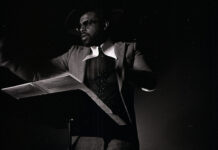The Stephen Sondheim and Hugh Wheeler musical A Little Night Music (currently playing at the Pasadena Playhouse), has an unusual structure. Instead of a traditional overture, five vocalists offer some unique material and a preview of the songs that will appear later in the musical. That is followed by a short scene that serves as a prelude. Then we get to the first song. Or should I say, songs. For it is in Now/Later/Soon that we are introduced to three of the main characters and one of the love triangles in the show that gets this musical rolling.
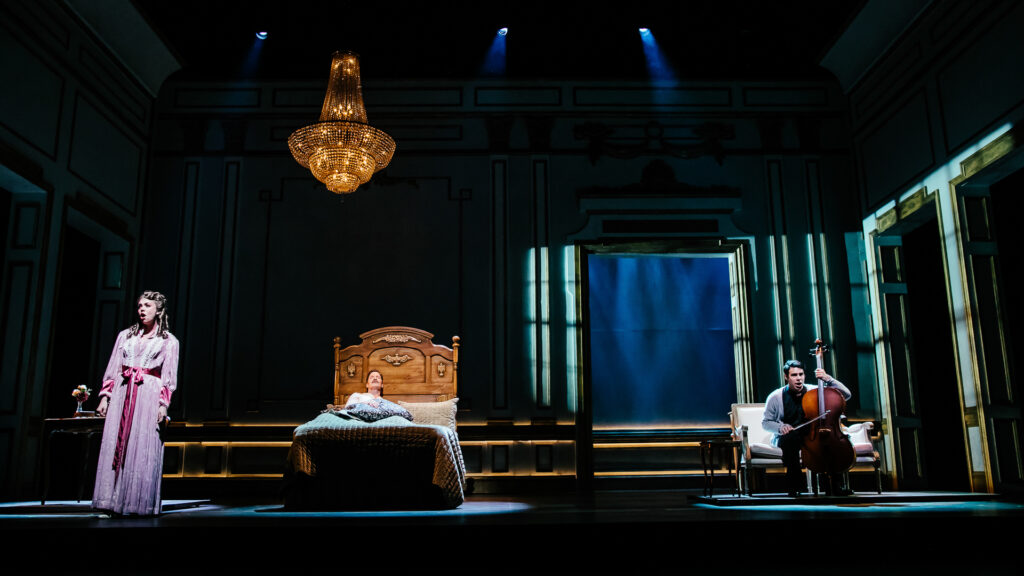
Now is sung by Fredrik who has been married to his 18-year-old bride Anne for 11 months. He is still waiting to consummate the relationship. His son Henrik is in love with his stepmother and is constantly told that his cello playing and the things he wants to discuss have to be put off until Later. Anne promises Fredrik that she will have sex with him Soon.
The brilliance of Sondheim is that after each character has their solos, all three sing of their desires and needs in a very complicated trio that ultimately reveals more about each than they ever intended.
Being a fan of this particular part of A Little Night Music, I wanted to find out what it takes to perform Now/Later/Soon. So during rehearsals for this production, I spoke to Michael Hayden (Fredrik), Chase Del Rey (Henrik) and Kaley Ann Vorhees (Anne) about the challenges of this number and what it tells us about their characters and, perhaps, about us as an audience. What follows are excerpts from our conversation that have been edited for length and clarity. To watch the full interview, please go here.
Q: Sondheim was quoted as saying in 2003, “Every time I see A Little Night Music I trudge in like a schoolboy to class. Then I’m always surprised by how much I like it. It never fails.” What do you think he and Hugh Wheeler did so right with this that that schoolboy could suddenly be converted into a happy theatergoer?
Hayden: To get a really complicated and, at times, dark story to also be incredibly entertaining. And because of the different ages of the love stories, to speak to people at different ages in their lives, is a really deft piece of construction. This book is a great book. Not a good book. The scenes are complicated. They work. It’s a full meal. It’s a feast. It’s not a snack.
Del Rey: Sondheim is the highest level of where complexity, in terms of telling a story through music, is communicated to an audience. When you get your hands on something like A Little Night Music it’s a treat because they don’t come around as often as you think they would. Musically it’s amazing. The book is fantastic. The characters are rich and complex and I think this attracts actors. It doesn’t just attract musical theater performers.
Voorhees: The great thing that I think Sondheim does, and that the book does, is that it’s about humanity.You’re really thinking about different levels of humanity and how people interact with each other. I think that it’s attractive to all ages and it tells a story about people. You can come into it thinking what’s the through line? What’s the story about? You’re really feeling like you connected with something because the characters are well-written and easy to connect to.
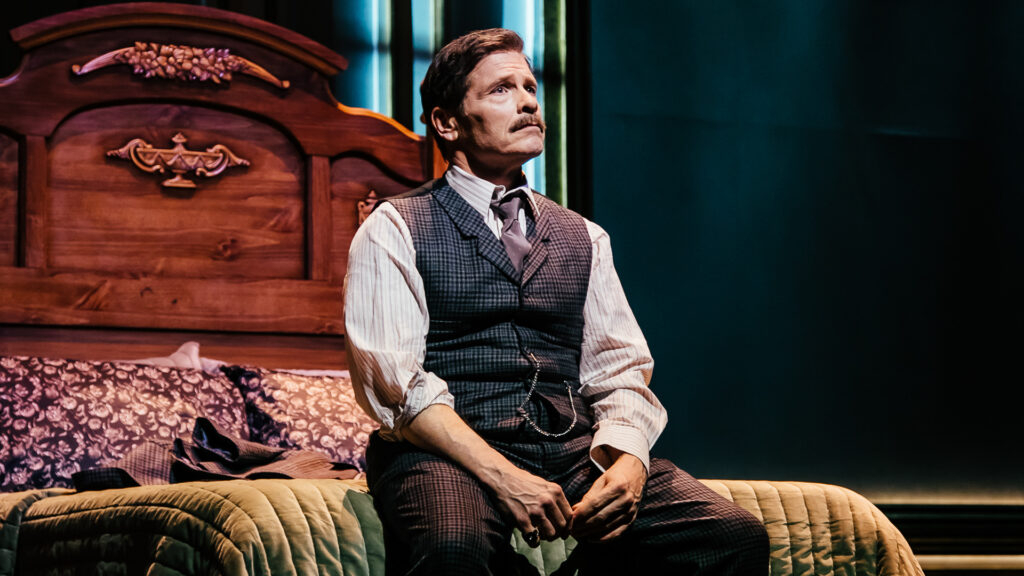
Q: The reality is the story’s about us, isn’t it?
Hayden: Absolutely. Every character, whether they’re the more silly ones or the more dramatic, this play circumvents tone. There’s no tone of the characters. It’s a roller coaster in the best way where every character gets a moment. Even the silliest ones have dignity.
Q: Sondheim regularly talked about how you need to let the audience know in the first few minutes what they can expect musically and story wise from a musical. What does Act One, Scene One in which Now/Later/Soon appears tell us about the show that’s going to follow?
Vorhees: Initially it tells you that the story is going to be told from more than one perspective and that it is about the relationships between the characters rather than one specific character. The focal point is the relationship rather than the person. You hear it both in the words that are spoken and musically. We each have our own sections of it Now/Later/Soon. We each tell our own story. But when we all come in together for the end of that trio, ultimately the thing that is most interesting is how they overlap.
Q: Sondheim called each of these three pieces inner monologue songs in which the characters “describe their deepest thoughts, almost never singing to one another.” What are the challenges in creating your own monologues so that monologue is clear for you and also for the audience so that when all three songs come together we can still keep track of what each person needs and wants?
Hayden: By the time we get to the trio, we have a very strong sense of what the conflicts are that they sing about anyway. This trio ends with the word Desiree. That, of course, pops her right into our consciousness. That is just a brilliant piece of storytelling. We know that we have a group of people on stage that are going to start weaving throughout the piece.
With verse it’s rare that you have subtext, so to speak. You have an inner life, but you say what you mean. You’re sharing a secret with the audience so that they know a secret about you, which creates the underbelly of all the action that comes after. So the audience is in on a secret sometimes that you don’t even fully know. Frederik doesn’t know that he mentioned Desiree’s name. We’ve got this complicated relationship taking place that’s about love, longing, hunger. So we know this is going to be a sexy, hungry story. At the end of that trio all those things are in play and we’re ready.
Q: Kaley, Sondheim also said that amongst his mistakes in his career was writing for an octave and six range, which he did, because Victoria Mallory, who originally did the part, could accomplish that. She could sing the low ends and the high ends. Anne has to go very high in A Weekend in the Country. He said, “I straitjacketed all subsequent singers into this rare combination.” Is he right? Is it as challenging as he fears it was?
Vorhees: I absolutely know what he’s talking about. It’s a wide range. You have to be ready for it. It’s Sondheim. So it has a sense of quickness and a sense of patter that is difficult to sing. But it’s honestly a lot of fun to do and it stretches you in a way that is exciting.
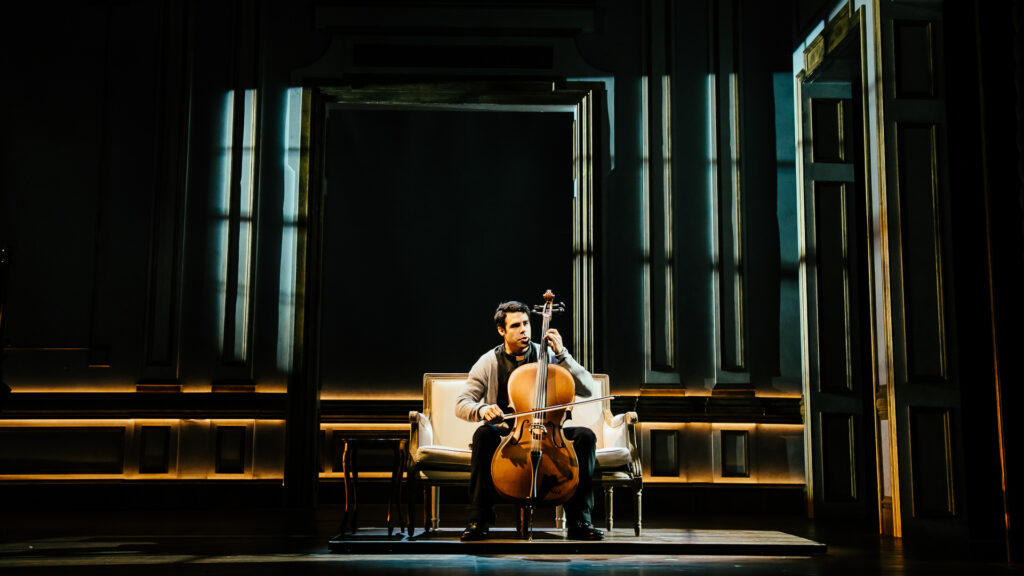
Q: Chase, Henrik is, by his own definition, “dammed up inside.” He’s repressed. What is the work you have to do so that all that repression is palpable for the audience, yet is never demonstrative, thereby removing that whole sense of repression?
Del Rey: The stakes are very high for him. What he wants more than anything is actually to be outside of being damned up inside. He’s confused. He bumbles through a lot of the show. That can be tricky because he’s not graceful with so much of his interactions on stage. I think there’s a couple of moments in the play where I just want him to be clear and defined.
He can’t stand these people out in the country. It drives him insane. He lets it break through in certain moments, especially in Act Two during that dinner scene. That moment should feel different. The audience should not know that Henrik was capable of getting to that place. The second [issue] is the love that he won’t allow himself to have.
Finally he gets to the point in both of those instances where the audience should, I hope, feel the release that Henrik is feeling. To feel that he was a person that needed love so badly and here’s a person that needed to say what he meant so badly about why everybody is so obnoxious.
Q: Michael, you you mentioned how brilliant it is that the last word in the trio is Desiree. What does that tell us about the journey that Frederik is on through this show? How does that take us to who Frederick is in the dialogue section that is in the middle of Send in the Clowns?
Hayden: Just in terms of basic storytelling we hear about Desiree. You know, boom. So we know where we’re off to next. You’re talking about Henrik’s character being repressed. You could rehearse this play as though we all came into rehearsal and we wore a coat of armor. We were going to rehearse this play as though each scene tore away a piece of that armor. So at the end of the play we were exposed for the first time. We discovered something – which is brilliant. For each character that only happens in the very last second of the play. Their eyes are open and they see what they were missing. Which is glorious, because then the audience gets there. They’re in the know.
By the time we’re done with Send in the Clowns, he’s done what he did again 14 years ago – broke her heart. It’s cruel what he does. I think it’s important to remember to listen to how many times the word death is brought up in this play. It struck me yesterday as I was listening to it. I was clocking each time it was said. I don’t think you can’t really experience a fullness of love or growing through whatever extraordinary events we go through in our lives. There is a depression. There is a kind of death and grieving. You leave something before you can get to the other side of something. It’s not pretty. It’s messy and everyone has to be stripped completely down before we see each other and admit exactly who and what we are. Then when we see each other that all falls away. Fantastic! That’s what I think Sondheim does which is so great. Wake up. Wake up! Wake up!! We finally do.
Q: By the time we get to the trio, the person who wants now becomes the person who is singing about soon. The one who wants later is singing about now. And the one who’s singing about soon is the one who is embracing later. What’s the journey each of your characters takes to get from what you originally sing about in the beginning to what you ultimately sing about at the end of the trio?
Voorhees: I think there is very much a moment that I am playing as acceptance because I think soon is sort of her struggle. At the end of the song you want there to be some big resolve. It obviously gets turned on its head a little bit with the very last line or the last couple lines. But I do think that there is a character arc of greater understanding of one’s self.
Del Rey: The stakes rise throughout that final crescendo with all three of us. It gets to the point, I think for Henrik, where he knows that he hates later. He hates that nothing ever begins. Then the word he says in repetition is soon. Soon. Come to me soon. If I’m dead, I can wait. But I want to live now. I’m ready for things to start. Soon. Soon, Soon. Soon. He says it four times. And it’s a big moment musically. That’s a huge arc of a song to go from I hate what this feels like right now. What do I want? I want things to start soon. Eventually [Henrik] gets to now. He gets to I’m ready.
Hayden: Those three words are primal. Those three words have everything to do with the conflicting desires of when you’re ready, when you’re not ready. I’ll do it. If. When? Later? Soon? But the words themselves are primal and they’re hungry.
Del Rey: They’re all about timing. Once you get to like the lyrics in Send in the Clowns, was my time wrong? Would my life have changed if I would have just started earlier? Did I miss out? Did I regret what I didn’t do? Will I regret it if I don’t do it? I think everybody has a version of that in this play. I think a huge throughline is timing. And Now/Later/Soon are all huge timing us for different reasons.
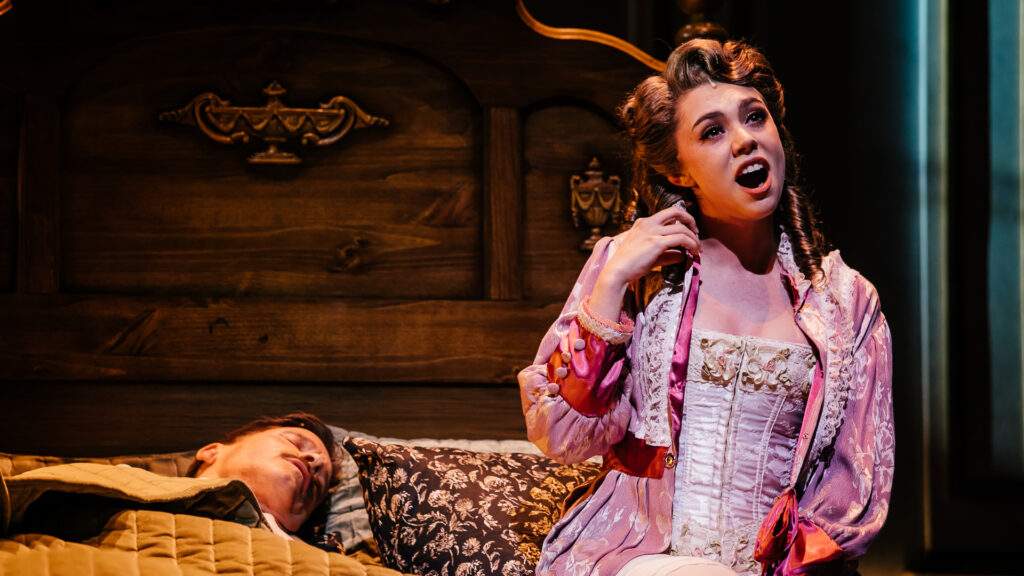
Q: In the prelude before Scene One, Madame Armfeldt tells Frederika about the smiles of the summer night. One smiles on the young. The second on the fools and the third on the old. How is the summer night smiling on each of you? And how is that reflected in your appearing in A Little Night Music?
Hayden: I’ve been really lucky in my career to get to do a decent number of pieces that I would call a feast in that we really did it right. Which is rare. To get to go on the ride that this guy goes through, being middle-aged myself, and telling a story – as all great love stories do – about coming back to life, that’s a great story to tell. For it to be a romantic, too, that’s a great story to tell right now. It’s always a great story to tell. It’s maddening how hard this piece is at times and I love every second I’m there. I don’t ever forget how lucky I am to be doing this play. You don’t always feel that way. That’s how I feel. I can’t wait to battle it out every night on stage in front of an audience. It’s going to be glorious.
Voorhees: I feel that we’ve all been smiled upon with the the casting which is fantastic. Everyone has been nothing but a joy to work with. I feel like I’ve learned so much from just watching and observing other people do their scenes and go on their journeys. More than just the the leads or people who you’re watching their characters grow. Even the chorus sounds amazing and they’re so dedicated to it and it’s going to be beautiful. I think that a lot of that has to do with the people that were brought into it. I feel very lucky and that this group of people is has the potential to create something that is beyond a lot.
Del Rey: I always want to run towards projects that scare me. This show has challenged me so much already. It’s going to make my art better. It makes me think about art better. It makes me strive to be better. When you get to go to work every day and dissect and there’s always more, that’s what makes me feel like I’m smiled upon. It’s really refreshing to be on stage again and to be reminded of why people go to the theater and why some of the best actors in the world start on stage and continue to circle back to the stage. There’s nothing else like it at all.
A Little Night Music continues at the Pasadena Playhouse through May 28th.
To see the full interview with Michael Hayden, Chase Del Rey and Kaley Ann Voorhees, please go here.
Main Photo: The company of Pasadena Playhouse’s production of A Little Night Music (Photo by Jeff Lorch/Courtesy Pasadena Playhouse)


